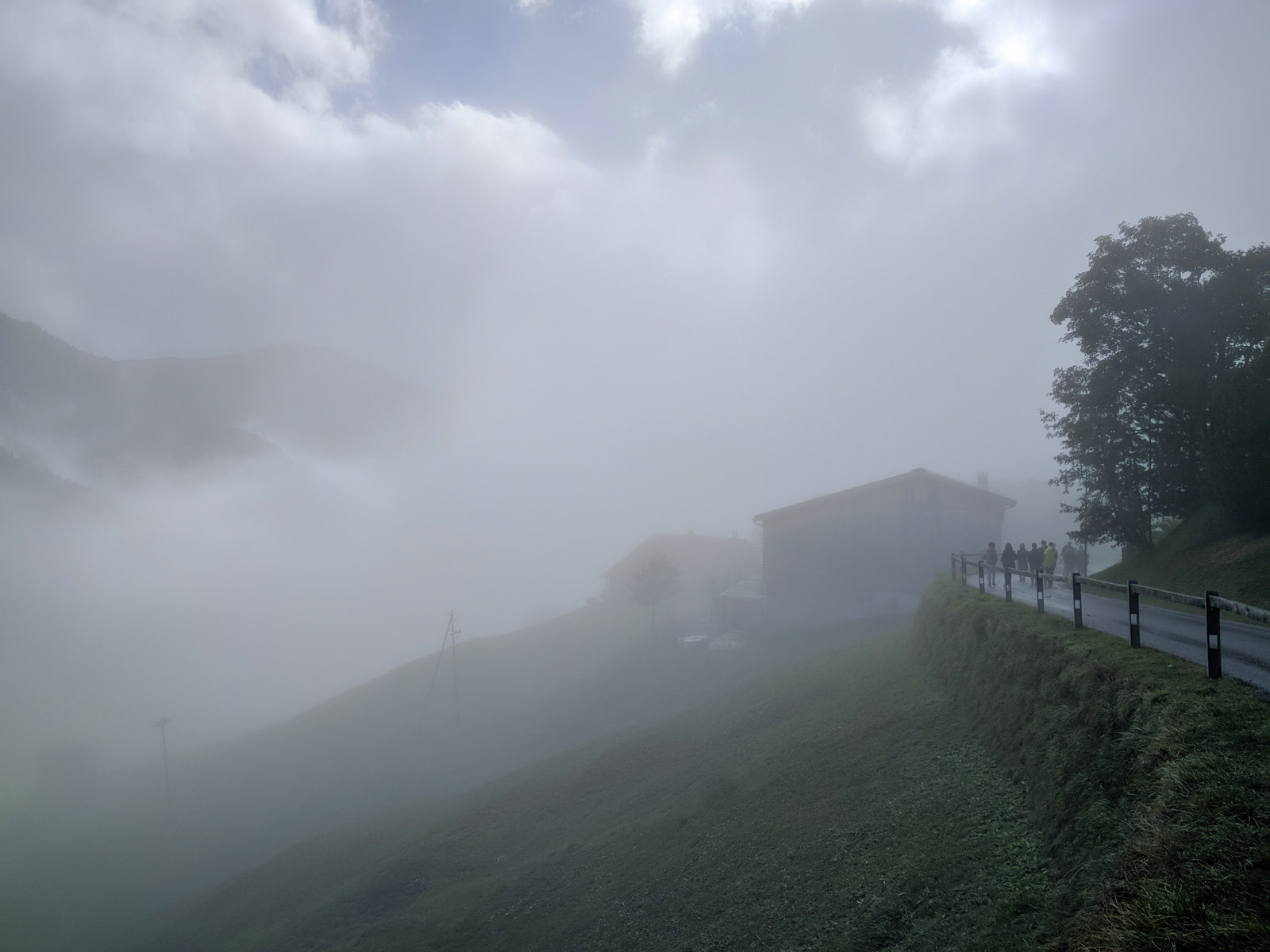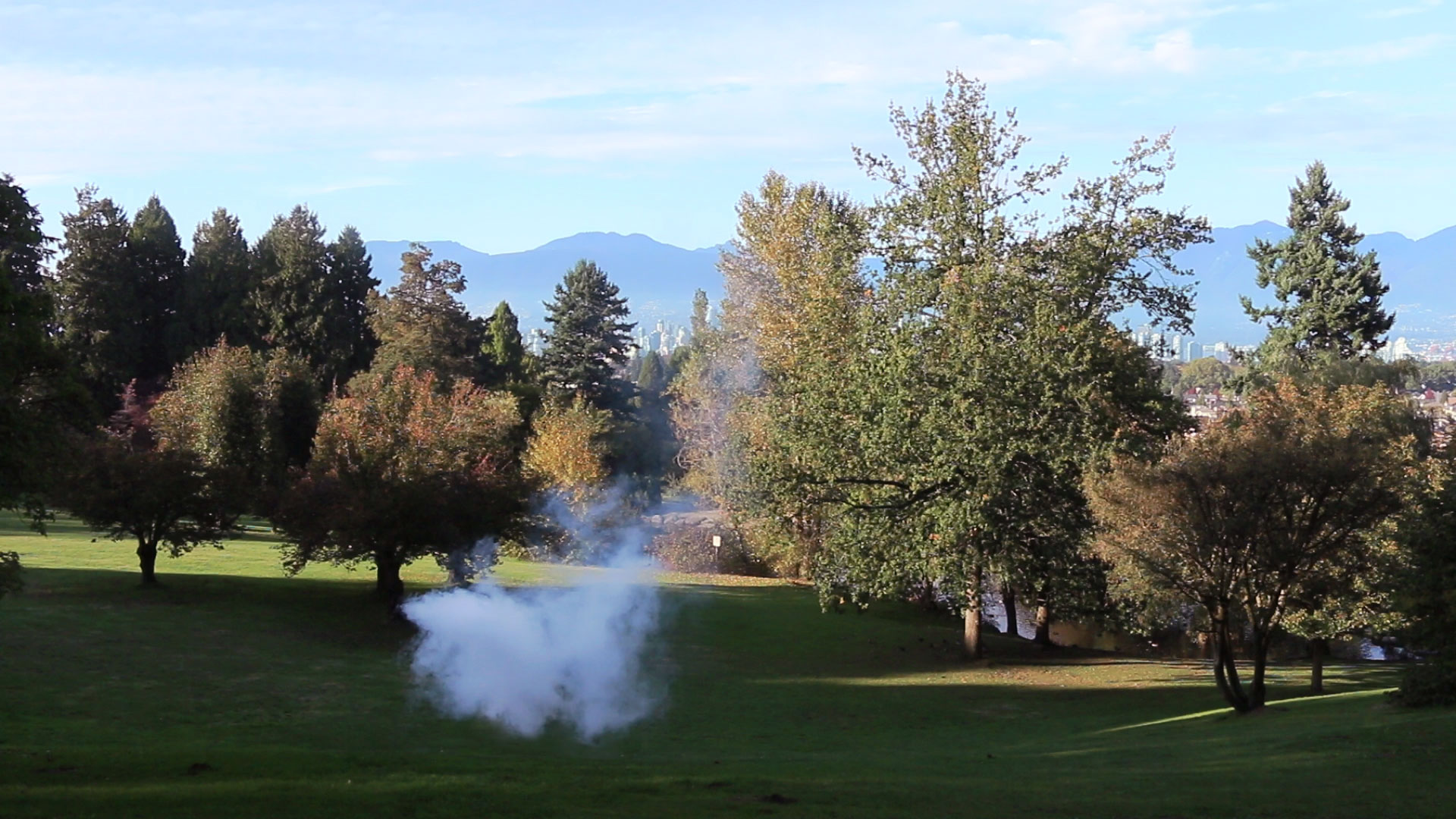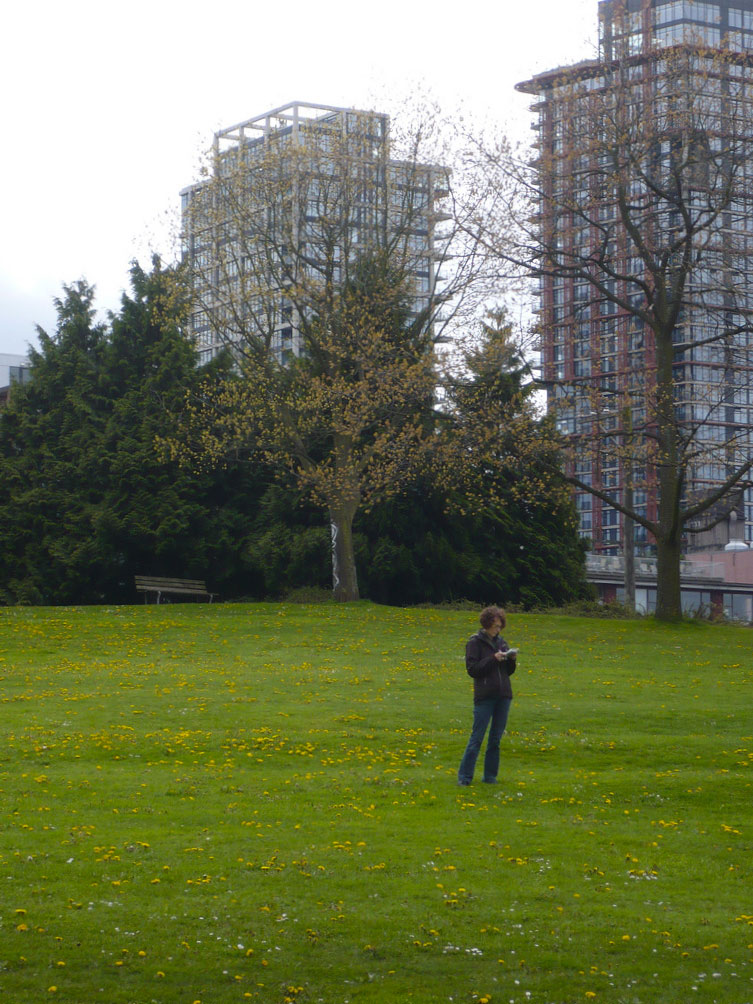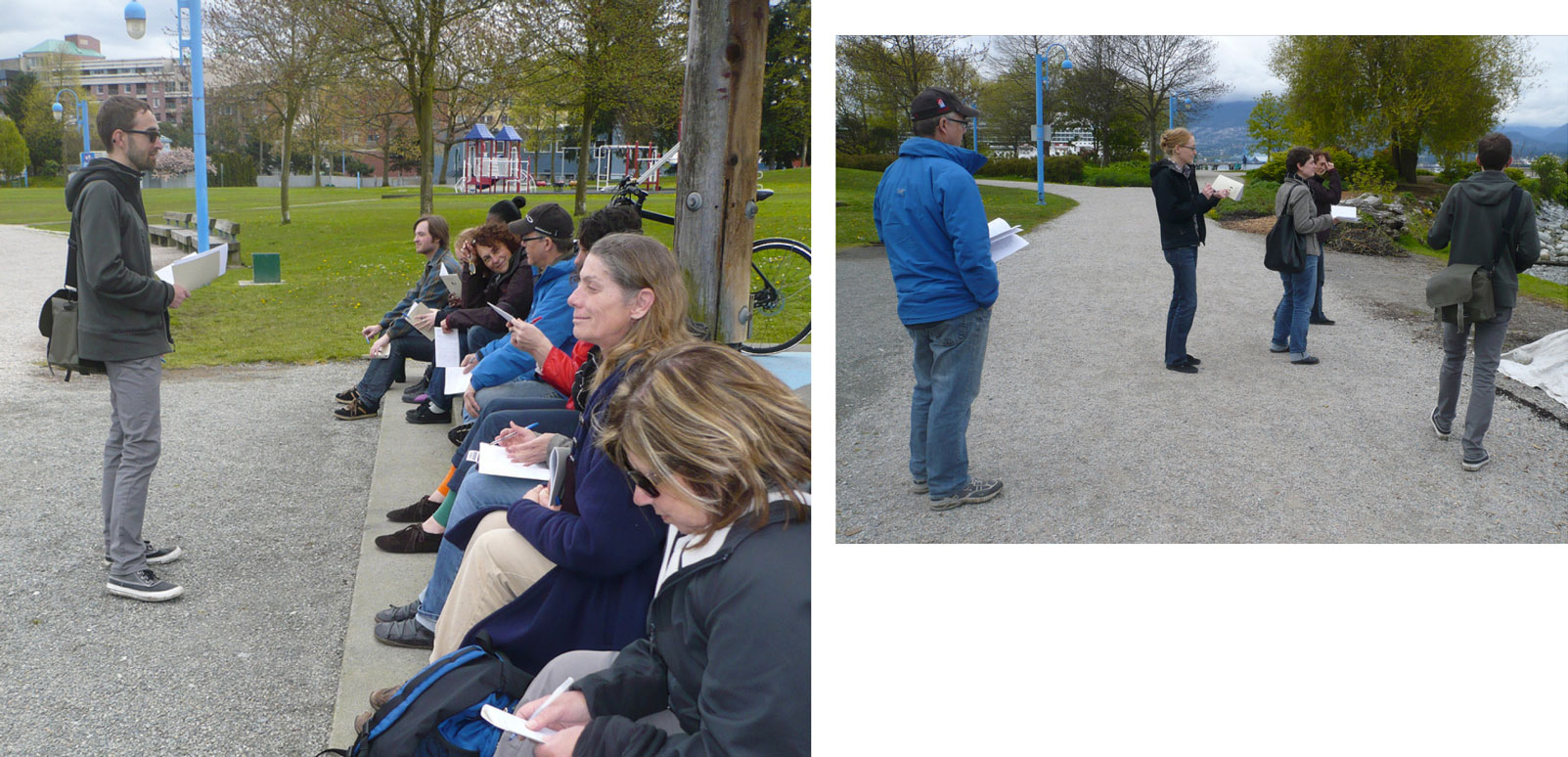
Air Tasting is a practice exploring the experience of the air, initiated as a collaboration between myself and Janine MacLeod in 2002. It takes the form of written sensory analysis, instructional workshops, guided walking tours, distillation of aromatic materials, and the staging of atmospheric effects. By presenting the atmospheric experience as a form of participatory embodied knowledge this work seeks to bring to people a direct awareness of the air as our shared habitat.
Conventionally, “tasting” refers to sensations that happen in the mouth, but renowned oenologist Emile Peynaud provides a more comprehensive and surprisingly philosophical definition:
Tasting is a way of life. We taste everything that comes into contact with our senses, be it a work of art, the present moment, the reality of existence. Looked at in this way, tasting is a means of perceiving and understanding the outside world; it presupposes a state of mind that is constantly receptive to sensation.
—Emile Peynaud. The Taste of Wine. 1983
Put simply, tasting is the attentive use of the senses; to taste is to bring to bear a focused sensory attention. I use the word in its broadest possible meaning: an expanded mode of attention and appreciation that involves all the senses. In this regard, tasting is the active cultivation of our sensorium.
Peynaud goes on to highlight the importance of attending to the senses:
It is obvious that we exploit only a fraction of our sensory potential, doubtless because we have not been trained to do more. … “In time one ceases to hear cars in the street, passing trains, the clatter of typewriters in a neighboring office, conversation at the next table. A subconscious barrier has been erected … ” We are gradually forgetting how to use our senses. From childhood on, city life cuts us off from the profusion of tastes and smells that occur in nature. Our instinctive curiosity about them is lost, and with it the potential to have our memories and feelings stirred.
This suggests that taste isn’t a purely innate ability, nor is it a capacity of the lone individual. Tasting is a cultural practice that is socially acquired and must be actively cultivated. So our tasting reveals as much about ourselves and our society as it does about the object of our degustation.
In the words of anthropologists Classen, Howes and Synott, "every society has a sensory order, and to every sensory order there corresponds a particular social and symbolic order."1 The conventions of food preparation and consumption are perhaps the most evident example of this interconnection; the sensory, the symbolic and the social are bound together in a culture of culinary taste that is acquired during early childhood and continues to develop into old age. In this light, the how of tasting is equally important to the what. Set and setting are desive in constituting the taste experience. From a multi-sensory perspective, drinking whisky alone in the morning is very different than drinking it in the evening with friends. Whisky served in a shot glass at an Ibiza beach club bears little resemblance to whisky in a Glencairn glass at the Christmas hearth.
I contend that such social conventions extend beyond food to shape all our sensory experiences. One might say that cultural practices of tasting function to transmit a society’s sensory order, and thereby also its social and symbolic order.
1 Classen, Howes and Synott. Aroma: The Cultural History of Smell. 1994: 161
While meteorology directs one’s attention away from the senses into abstract measurements and sweeping predictions about future atmospheric conditions at a generalized geographic location, Air Tasting focuses on a subjective perception of the air in a specific place at a particular moment, taking inspiration from Goethe’s claim that the human being oneself, to the extent that one makes sound use of one’s senses, is the most exact physical apparatus that can exist.
The sense of smell is well known for its ability to detect odourants at levels far below that of the most sensitive instruments, to discriminate between thousands of single odourants, and to engrave into memory recollections of scents that stretch far back into early childhood. In short, the capacity of the sense to detect, discriminate, and imprint odours is unmatched by man-made chemo-sensory devices.
—R. L. Doty. Handbook of Olfaction and Gustation. 1995. p.283
The atmosphere is a commons that connects us. According to astronomer Harlow Shapely the atoms you are now exhaling will spread across the country within a week, and within one year they will have traveled around the entire earth. In this sense our intimate bodily engagement with the air bridges all terrestrial distance. The air we breathe is arguably our most direct and essential connection to the world, a planetary material that is critical to our survival yet rarely the object of our immediate sensory awareness. I’m proposing that in this time of global climate crisis a deeper awareness of our daily engagement with the air is more important than ever.

Illustrating Shapley’s analysis of the atmosphere as a globally interconnection corporeal body, Cloud performance (shown above) creates a vapour cloud in order to make visible the interaction between air, weather, and landscape.
The air is a slippery object—how can we attend to something that is invisible, intangible, and changes from one moment to the next?
We might experience the air as a combination of haptic, thermoceptive, olfactory, sonic, and visual sensations; for example: a cool, humid, foggy breeze with a briny aroma blows in from the ocean and whistles through the trees. But these sensations are only momentary and subject to continual change, so what is it that binds all these perceptions together into the image of a unified object we refer to as the “air”?
For Peynaud this challenge of grasping sensations is central in the pursuit of tasting:
As a winetaster you must be able to create a sensory void within and around yourself, excluding any superfluous sensations which might distract your attention. […] Tasting is an act of self-examination where the winetaster stands apart from themself looking on as their mind’s eye scans fleeting impressions […] probing their memory for images and reference points.
[…] A practical difficulty during tasting is knowing when to concentrate on what. In effect, your attention needs to be focused on something specific and yet remain sufficiently flexible to notice other sensations as well. […] On the other hand, you only recognize what you can put a name to, and for a sensation to have a name you need to memorize its identity at the same time as you register its presence.

So according to Peynaud, tasting is an inherently language-based process, and also a social one. He continues:
The act of drinking is usually silent whereas that of tasting involves speaking. It is rare for those who are just having a drink to make comments on their sensations; they do not always analyze them, or at most they say that something is good or bad. … The winetaster, however, is obliged to describe their sensations and to make a judgment. They taste in order to increase their knowledge of wine and to talk about it.
In other words, tasting is the transformation of sensation into a shared cultural practice by means of language.
By naming and describing our sensations we can bring them further into our awareness and increase our perception. The act of description isn’t passive; it’s an active and collaborative process that enhances the senses.
By focusing the mind in different ways one can gain access to sensations that would otherwise go unregistered. […] It has been observed that through a practice of describing smells one can in fact bring more of these sensations into one’s conscious awareness!
—Sensory researcher Piet Vroon
But describing sensation isn’t easy, especially when it comes to smells. In Peynaud’s words,
The taster is frequently aware of his inability to describe an impression, even with the taste in his mouth, the smell in his nostrils, and the words on the tip of his tongue. [… ] When trying to talk about wine in depth, one rapidly comes up against the limitations of our means of expression, against the barrier of the inexpressible. We need to be able to describe the indescribable. […] Not all words are faithful messengers; I have, however, come across many examples where the right word revealed and triggered the sensation.
Peynaud describes this process as cultivating “inroads into the inexpressible.”
Air Tasting turns Peynaud’s wine tasting methods towards the atmosphere, using language as a tool for prehending the air by guiding, training and focusing awareness through the senses. Through this mode of experiential study Air Tasting aims to develop tools and methods of perceptual exploration and to facilitate an engaged, critical understanding of sensory perception.

The practice of Air Tasting examines our sensory experience of the air through a method of self-observation that adapts techniques from the field of sensory analysis, a scientific discipline that deals with the study of human senses and how they perceive and interpret various stimuli. Sensory analysis techniques have been developed in several different domains of research and commercial product development, most notably oenology (the study of wine), perfumery, and flavour engineering. The Air Tasting method turns these techniques of sensory observation towards the air, to explore the aromas and atmospheric phenomena of particular places. This exercise of directed visual, haptic and olfactory perception employs a combination of mindfulness, writing and discussion to engage in an embodied participatory knowing of the air as a speculative object.